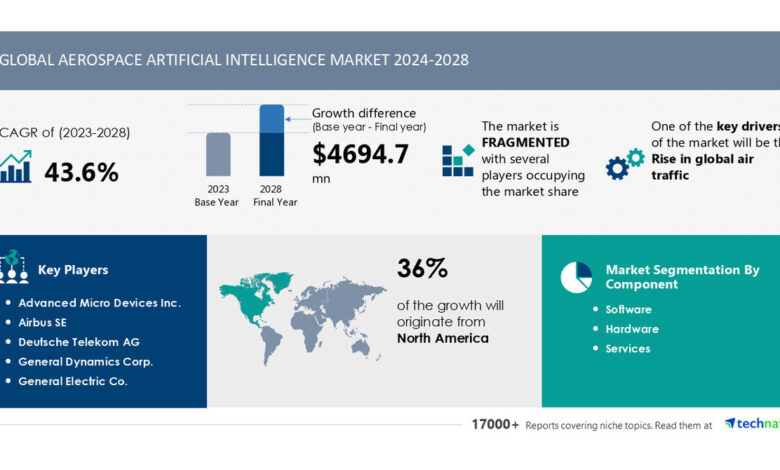Aerospace Artificial Intelligence Market size is set to grow by USD 4.69 billion from 2024-2028, Rise in global air traffic boost the market, Technavio

NEW YORK, May 30, 2024 /PRNewswire/ — The global aerospace artificial intelligence market size is estimated to grow by USD 4.69 billion from 2024-2028, according to Technavio. The market is estimated to grow at a CAGR of 43.6% during the forecast period.
For more insights on the forecast market size and historic data (2018 – 2022) – Download a Sample Report
Segment Overview
- Component
- 1.1 Software
- 1.2 Hardware
- 1.3 Services
- End-user
- 2.1 Machine learning
- 2.2 Natural language processing
- 2.3 Computer vision
- 2.4 Context awareness computing
- Geography
- 3.1 North America
- 3.2 Europe
- 3.3 APAC
- 3.4 Middle East and Africa
- 3.5 South America
1.1 Software- Aerospace Artificial Intelligence (AI) market growth is driven by the integration of AI software in unmanned aerial vehicles (UAVs), drones, and spacecraft. This software optimizes performance, enhances safety, and predicts equipment failures for proactive maintenance. In mission planning, AI considers various factors for efficient and effective plans.
Space exploration benefits from AI for autonomous navigation, object recognition, and data analysis. Air traffic management systems use AI for optimized air traffic flow and conflict resolution. Overall, AI enhances communication systems’ efficiency and reliability, contributing to the market’s expansion.
For more information on market segmentation with geographical analysis including forecast (2024-2028) and historic data (2017-2021) – Download a Sample Report
|
Aerospace Artificial Intelligence Market Scope |
|
|
Report Coverage |
Details |
|
Base year |
2023 |
|
Historic period |
2018 – 2022 |
|
Forecast period |
2024-2028 |
|
Growth momentum & CAGR |
Accelerate at a CAGR of 43.6% |
|
Market growth 2024-2028 |
USD 4694.7 million |
|
Market structure |
Fragmented |
|
YoY growth 2022-2023 (%) |
40.42 |
|
Regional analysis |
North America, Europe, APAC, Middle East and Africa, and South America |
|
Performing market contribution |
North America at 36% |
|
Key countries |
US, China, Japan, Russia, and Germany |
|
Key companies profiled |
Advanced Micro Devices Inc., Airbus SE, Deutsche Telekom AG, General Dynamics Corp., General Electric Co., Honeywell International Inc., Indra Sistemas SA, Infosys Ltd., Intel Corp., International Business Machines Corp., Iris Automation Inc., Lockheed Martin Corp., Microsoft Corp., Northrop Grumman Corp., NVIDIA Corp., Raytheon Technologies Corp., SITA, SparkCognition Inc., Thales Group, and Shield AI |
Market Driver
The integration of Natural Language Processing (NLP) in the aerospace industry’s artificial intelligence (AI) market significantly enhances human-machine interaction in cockpit systems. NLP allows pilots to communicate with aircraft systems using natural language commands, improving user experience and reducing cognitive workload.
Advanced NLP systems understand various accents and languages, making them essential in the diverse global aerospace industry. NLP also enables voice-controlled cockpit operations, streamlines processes, and enhances situational awareness for informed decision-making. Integration with AI-based virtual assistants further enhances the intelligent and supportive cockpit environment. NLP’s adoption in pilot training programs also boosts proficiency and market growth during the forecast period.
The aerospace industry is increasingly adopting Artificial Intelligence (AI) to enhance operations and improve efficiency. Machine learning algorithms are being used for predictive maintenance in aviation, while computer vision technology is being applied to drones for object detection and recognition. Autopilot systems are becoming more sophisticated, allowing for safer and more efficient flights. Markets for aerospace AI are growing, with components and software in high demand.
Companies are investing in research and development to stay competitive. Safety and security are top priorities, with regulations being put in place to ensure the safe integration of AI into aerospace systems. The future of aerospace AI looks bright, with advancements in areas such as satellite imaging and route optimization set to revolutionize the industry.
Market Challenges
- The aerospace artificial intelligence market faces significant challenges due to data security and privacy concerns. Unauthorized access to sensitive flight data and operational parameters could compromise aviation safety and efficiency. Cyber threats targeting AI systems increase the attack surface, posing risks such as disrupting flight operations, manipulating data, or compromising algorithm integrity. Protecting communication systems and training datasets is crucial to prevent unauthorized access and potential misuse of aviation-related information.
- Compliance with data protection regulations, such as GDPR, adds complexity. Balancing security needs with privacy rights is essential when processing passenger data. Maintaining AI system security over extended operational lifecycles and addressing evolving cybersecurity threats are ongoing challenges. Ethical concerns related to surveillance and monitoring also require careful consideration. These challenges may inhibit market growth during the forecast period.
- The aerospace industry is increasingly adopting Artificial Intelligence (AI) to enhance operational efficiency and innovation. However, implementing AI in this sector comes with unique challenges. One major challenge is ensuring data accuracy and reliability in complex and dynamic environments. Another challenge is integrating AI systems with existing legacy systems and ensuring compatibility. Additionally, ensuring data security and privacy in the context of increasing data usage is a significant concern.
- Furthermore, the need for real-time processing and decision-making in critical situations requires robust and reliable AI systems. Lastly, the high cost of developing and implementing AI solutions in the aerospace industry remains a significant barrier. Despite these challenges, the potential benefits of AI in areas such as predictive maintenance, autonomous systems, and optimization of operations make it a worthwhile investment for the future of the aerospace industry.
Research report provides comprehensive data on impact of trend, driver and challenges – Request a sample report!
Research Analysis
The Aerospace Artificial Intelligence (AI) market is experiencing significant growth due to the integration of advanced technologies such as machine learning, computer vision, and big data analytics in various applications. AI models are being utilized in flight operations for predictive maintenance, pilot training, and air traffic control. In customer service, AI software is used for voice recognition and virtual assistant services to enhance the overall flying experience.
Computer programs that mimic human intelligence are being employed for observation tasks, including time series analysis to optimize aircraft performance and improve safety. AI is revolutionizing the aerospace sector by automating repetitive tasks, enhancing decision-making capabilities, and increasing operational efficiency.
Market Research Overview
The Aerospace Artificial Intelligence (AI) market encompasses the development, implementation, and integration of AI technologies in the aerospace industry. This includes the use of machine learning, deep learning, computer vision, and natural language processing in areas such as flight control, maintenance, and manufacturing. The market is driven by the need to increase efficiency, reduce costs, and improve safety in the aerospace sector.
Applications of AI in aerospace range from predictive maintenance of aircraft components to autonomous flight control systems. The market is expected to grow significantly due to increasing investments in research and development and the increasing demand for smart and connected aerospace systems. Safety and security concerns, however, remain key challenges in the market. The use of AI in aerospace also raises ethical and regulatory issues that need to be addressed.
Table of Contents:
1 Executive Summary
2 Market Landscape
3 Market Sizing
4 Historic Market Size
5 Five Forces Analysis
6 Market Segmentation
- Component
- Software
- Hardware
- Services
- End-user
- Machine Learning
- Natural Language Processing
- Computer Vision
- Context Awareness Computing
- Geography
- North America
- Europe
- APAC
- Middle East And Africa
- South America
7 Customer Landscape
8 Geographic Landscape
9 Drivers, Challenges, and Trends
10 Company Landscape
11 Company Analysis
12 Appendix
About Technavio
Technavio is a leading global technology research and advisory company. Their research and analysis focuses on emerging market trends and provides actionable insights to help businesses identify market opportunities and develop effective strategies to optimize their market positions.
With over 500 specialized analysts, Technavio’s report library consists of more than 17,000 reports and counting, covering 800 technologies, spanning across 50 countries. Their client base consists of enterprises of all sizes, including more than 100 Fortune 500 companies. This growing client base relies on Technavio’s comprehensive coverage, extensive research, and actionable market insights to identify opportunities in existing and potential markets and assess their competitive positions within changing market scenarios.
Contacts
Technavio Research
Jesse Maida
Media & Marketing Executive
US: +1 844 364 1100
UK: +44 203 893 3200
Email: [email protected]
Website: www.technavio.com/
SOURCE Technavio



